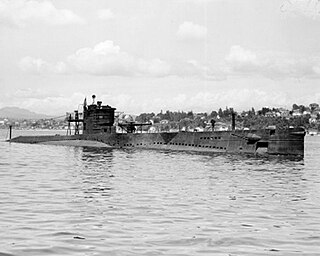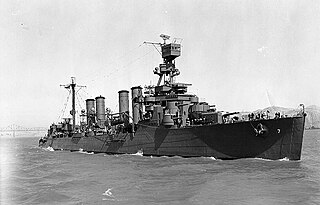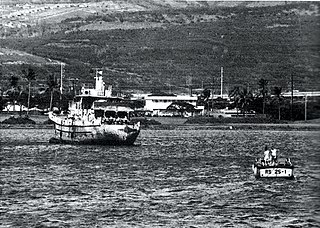
USS Mustin (DD-413) was a Sims-class destroyer of the United States Navy, the first Navy ship of that name, in honor of Captain Henry C. Mustin (1874–1923), a pioneer of naval aviation.

USS S-28 (SS-133) was an S-class submarine of the United States Navy. A diesel submarine, she served in World War II during which sank one Japanese ship. She was lost at sea with all hands in July 1944. Her wreck was discovered in 2017 at a depth of 8,500 feet (2,600 m) off the coast of Oahu.

The third USS Farragut (DD-348) was named for Admiral David Glasgow Farragut (1801–1870). She was the lead ship of her class of destroyers in the United States Navy.

USS Raleigh (CL-7) was the fourth Omaha-class light cruiser, originally classified as a scout cruiser, built for the United States Navy. She was the third Navy ship named for the city of Raleigh, North Carolina. The first being Raleigh, a 32–gun frigate built in 1776, during the American Revolution, and captured by the British in 1778. The second was the protected cruiser Raleigh, commissioned in 1894, and decommissioned in 1919.

USS Williamson (DD-244/AVP-15/AVD-2/APD-27) was a Clemson-class destroyer in the United States Navy during World War II. She was named for Commander William Price Williamson.

USS Gillis (DD-260/AVD-12) was a Clemson-class destroyer in the United States Navy. She was named for Commodore John P. Gillis and Rear Admiral James Henry Gillis.
USS Nanigo (YTB-537/YTM-537), a harbor tug of the United States Navy, was laid down on 6 December 1944 by the Consolidated Shipbuilding Corp., Morris Heights, New York, launched on 27 March 1945; and placed in service on 30 August 1945.

USS Stoddard (DD-566) was a Fletcher-class destroyer of the United States Navy, named for Master's Mate James Stoddard, who was awarded the Medal of Honor during the Civil War. She was the last Fletcher to be stricken from the U.S. Navy, in 1975.

USS Watts (DD-567) was a Fletcher-class destroyer of the United States Navy.

USS Gilmore (DE-18) was an Evarts-class short-hull destroyer escort in the service of the United States Navy.

USS Oriole (AM-7) was a Lapwing-class minesweeper acquired by the U.S. Navy for the dangerous task of removing mines from minefields laid in the water to prevent ships from passing.
USS Annoy (AM-84) was an Adroit-class minesweeper of the United States Navy. She was laid down on 3 December 1941 at Portland, Oregon, by the Commercial Iron Works; launched on 6 April 1942; and commissioned on 2 September 1942. In 1944 she was reclassified as a patrol craft and renamed PC-1588.

USS Butternut (AN-9/YN-4/ANL-9/YAG-60) was laid down as a yard net tender on 11 March 1941 at Houghton, Washington, by the Lake Washington Shipyard; launched on 10 May 1941; and placed in service at the Puget Sound Navy Yard on 3 September 1941.
USS PC-817 was a PC-461-class submarine chaser built for the United States Navy during World War II. She was later renamed Welch (PC-817) but never saw active service under that name.
USS Anaqua (AN-40/YN-59) was an Ailanthus-class net laying ship which served with the United States Navy in the Western Pacific Theater of Operations during World War II. She served the U.S. Pacific Fleet with her protective anti-submarine nets, and returned home safely after the war.

USS Elder (AN-20/YN-15) was an Aloe-class net laying ship which was assigned to serve the U.S. Navy during World War II with her protective anti-submarine nets.
USS Buckthorn (YN-9/AN-14) was an Aloe-class net laying ship built for the United States Navy during World War II. Originally ordered as USS Dogwood (YN-3), she was renamed and renumbered to Buckthorn (YN-9) before construction began in December 1940. She was launched in March 1941, and completed in September 1941. Placed in service at that time without being commissioned, she was commissioned in December 1942, and decommissioned in August 1947. She was placed in reserve in 1947 and scrapped in 1976.

USS Buckeye (AN-13/YN-8) was an Aloe-class net laying ship in service with the United States Navy from 1942 to 1947. In the late 1970s and 1980s, she was used as a salvage training hulk.

USS Aloe (AN-6/YN-1) was an Aloe-class net laying ship which was assigned to serve U.S. Navy ships and harbors during World War II with her protective anti-submarine nets.

VPB-43 was a Patrol Bombing Squadron of the U.S. Navy. The squadron was established as Patrol Squadron 43 (VP-43) on 21 July 1941, redesignated Patrol Bombing Squadron 43 (VPB-43) on 1 October 1944 and disestablished on 15 September 1945.














